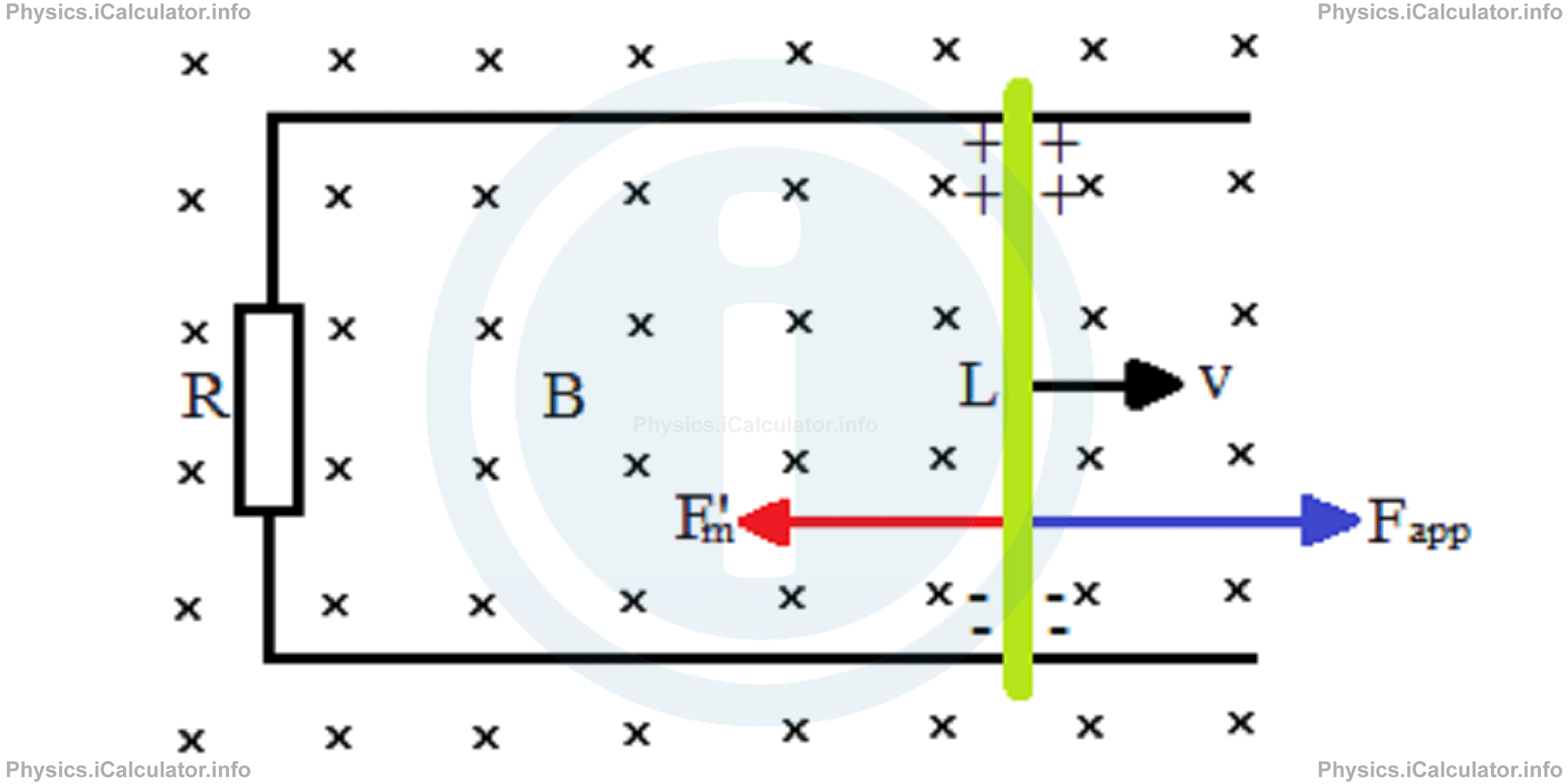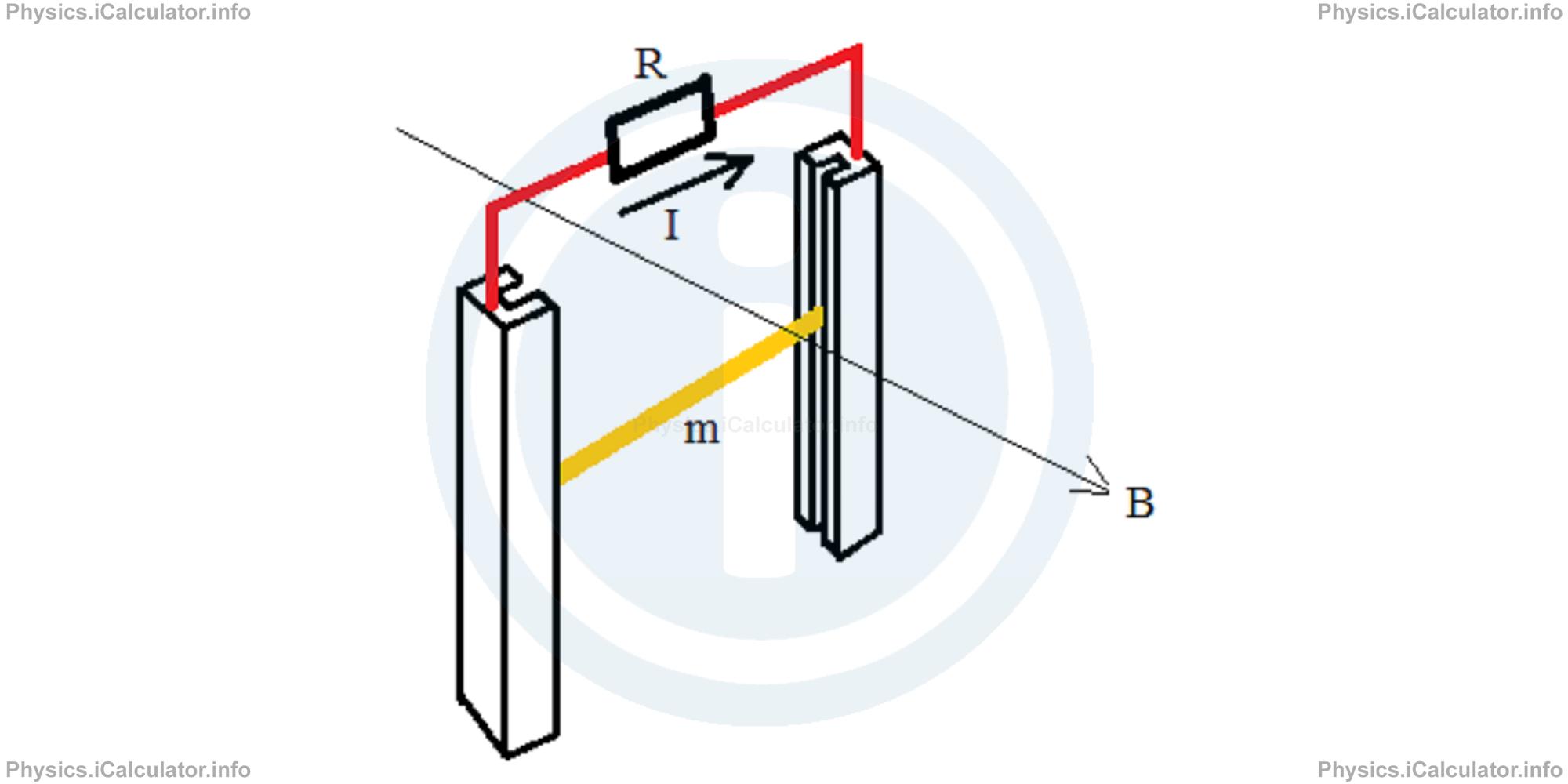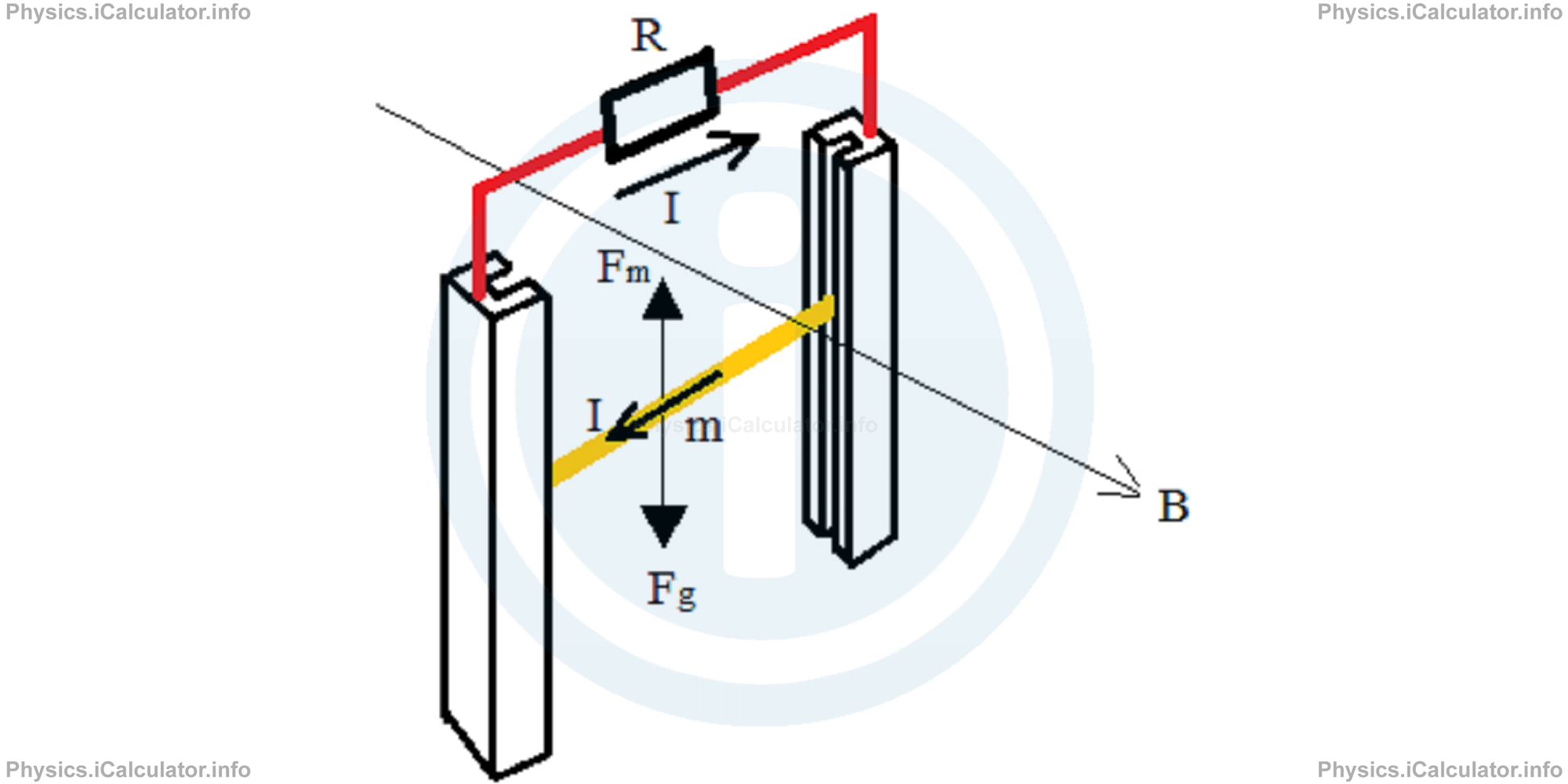Menu
Physics Lesson 16.7.4 - Motional Emf and Electrical Energy
Please provide a rating, it takes seconds and helps us to keep this resource free for all to use
Welcome to our Physics lesson on Motional Emf and Electrical Energy, this is the fourth lesson of our suite of physics lessons covering the topic of Faraday's Law of Induction, you can find links to the other lessons within this tutorial and access additional physics learning resources below this lesson.
Motional Emf and Electrical Energy
When a motional emf causes a current, a second magnetic force produced because of the current I produced in the bar. (Remember, the first magnetic force is due to the interaction of the moving bar and magnetic field B; it lies is in the direction of bar). The new magnetic force F'm produced in this case, opposes the applied force Fapp that is used to move the bar. The magnitude of this new magnetic force is
where I is the current induced in the circuit, L is the length of the bar and θ is the angle formed by the bar and the direction of the magnetic field (here sin θ = 1 because θ = 90°). Look at the figure.

If the external applied force Fapp is numerically equal to the new magnetic force discussed above, the bar moves at constant speed v. The external force Fapp does some work Wapp against the magnetic force during the bar's motion. This work is equal to the electrical energy produced in the circuit.
From the definition of electromotive force, we have for the induced emf in the circuit:
(Here W is the work done to move the charges throughout the bar, not the work done to move the bar itself; they are completely different things.)
Therefore, we obtain:
where FM is the original magnetic force discussed earlier (here FM is directed downwards). Thus, since
we obtain the known equation for the induced emf after substitutions,
= B ∙ v ∙ L
The power P delivered by the applied force Fapp is
= F'm ∙ v
= I ∙ B ∙ L ∙ v
= (εi/R) ∙ B ∙ L ∙ v
= (B ∙ v ∙ L/R) ∙ B ∙ L ∙ v
= B2 ∙ v2 ∙ L2/R
Thus, we can write
The last formula is interpreted as follows:
"The power delivered by the applied force in the above setup is equal to the rate at which the electrical energy is dissipated in the resistor."
The direction of current is in accordance with the law of conservation of energy. If the current was flowing is in the opposite direction, the direction of the new magnetic force would reverse; this means the bar would experience some acceleration as both the applied force Fapp and the new magnetic force F'm are in the same direction. Even if no external force was present, the bar would accelerate because of the new magnetic force. This means the bar moves without doing any work on it and therefore, it produces electrical energy out of nothing. This is impossible as it represents a violation of the law of energy conservation (energy can neither produced from nothing neither it can disappear; it only converts from one form into another).
Example 3
A 400 g conducting bar, which is 20 cm long, is free to slide between two copper tracks. A 4 Ω resistor is connected between the upper ends of the tracks. The system is placed inside a constant magnetic field of magnitude equal to 5T. The magnetic field lines are perpendicular to the plane of the system. The bar is sliding downwards at constant velocity due to the effect of gravity.

Calculate:
- The current in the resistor
- The moving velocity of the bar
- The power in the resistor
Solution 3
Clues:
m = 400 g = 0.4 kg
L = 20 cm = 0.2 m
R = 4 Ω
B = 5 T
θ = 90°
I = ?
v = ?
P = ?
- Based on the Fleming's Left Hand Rule, we find out that the direction of magnetic force produced on the bar is upwards. Since the bar is moving at constant speed, this magnetic force is balanced by the gravitational force acting on the bar.
 Numerically, we have FM = Fg
Numerically, we have FM = Fg
I ∙ B ∙ L = m ∙ g
I = m ∙ g/B ∙ L
= (0.4 kg) ∙ (9.81 m/s2 )/(5 T) ∙ (0.2 m)
= 3.924 A - To find the moving speed of bar, first we must calculate the emf induced in the circuit. We have εi = I ∙ RHence, giving that
= (3.924 A) ∙ (4 Ω)
= 15.696 Vεi = B ∙ v ∙ Lwe obtain for the speed v after rearranging the above equationv = εi/B ∙ L
= 15.696 V/(5 T) ∙ (0.2 m)
= 15.696 m/s - From the definition of electric power, we have for the power delivered in the resistorP = εi ∙ I
= 15.696 V ∙ 3.924 A
= 61.591 W
You have reached the end of Physics lesson 16.7.4 Motional Emf and Electrical Energy. There are 4 lessons in this physics tutorial covering Faraday's Law of Induction, you can access all the lessons from this tutorial below.
More Faraday's Law of Induction Lessons and Learning Resources
Whats next?
Enjoy the "Motional Emf and Electrical Energy" physics lesson? People who liked the "Faraday's Law of Induction lesson found the following resources useful:
- Motional Emf Feedback. Helps other - Leave a rating for this motional emf (see below)
- Magnetism Physics tutorial: Faraday's Law of Induction. Read the Faraday's Law of Induction physics tutorial and build your physics knowledge of Magnetism
- Magnetism Revision Notes: Faraday's Law of Induction. Print the notes so you can revise the key points covered in the physics tutorial for Faraday's Law of Induction
- Magnetism Practice Questions: Faraday's Law of Induction. Test and improve your knowledge of Faraday's Law of Induction with example questins and answers
- Check your calculations for Magnetism questions with our excellent Magnetism calculators which contain full equations and calculations clearly displayed line by line. See the Magnetism Calculators by iCalculator™ below.
- Continuing learning magnetism - read our next physics tutorial: Lentz Law
Help others Learning Physics just like you
Please provide a rating, it takes seconds and helps us to keep this resource free for all to use
We hope you found this Physics lesson "Faraday's Law of Induction" useful. If you did it would be great if you could spare the time to rate this physics lesson (simply click on the number of stars that match your assessment of this physics learning aide) and/or share on social media, this helps us identify popular tutorials and calculators and expand our free learning resources to support our users around the world have free access to expand their knowledge of physics and other disciplines.
Magnetism Calculators by iCalculator™
- Angular Frequency Of Oscillations In Rlc Circuit Calculator
- Calculating Magnetic Field Using The Amperes Law
- Capacitive Reactance Calculator
- Current In A Rl Circuit Calculator
- Displacement Current Calculator
- Electric Charge Stored In The Capacitor Of A Rlc Circuit In Damped Oscillations Calculator
- Electric Power In A Ac Circuit Calculator
- Energy Decay As A Function Of Time In Damped Oscillations Calculator
- Energy Density Of Magnetic Field Calculator
- Energy In A Lc Circuit Calculator
- Faradays Law Calculator
- Frequency Of Oscillations In A Lc Circuit Calculator
- Impedance Calculator
- Induced Emf As A Motional Emf Calculator
- Inductive Reactance Calculator
- Lorentz Force Calculator
- Magnetic Dipole Moment Calculator
- Magnetic Field At Centre Of A Current Carrying Loop Calculator
- Magnetic Field In Terms Of Electric Field Change Calculator
- Magnetic Field Inside A Long Stretched Current Carrying Wire Calculator
- Magnetic Field Inside A Solenoid Calculator
- Magnetic Field Inside A Toroid Calculator
- Magnetic Field Produced Around A Long Current Carrying Wire
- Magnetic Flux Calculator
- Magnetic Force Acting On A Moving Charge Inside A Uniform Magnetic Field Calculator
- Magnetic Force Between Two Parallel Current Carrying Wires Calculator
- Magnetic Potential Energy Stored In An Inductor Calculator
- Output Current In A Transformer Calculator
- Phase Constant In A Rlc Circuit Calculator
- Power Factor In A Rlc Circuit Calculator
- Power Induced On A Metal Bar Moving Inside A Magnetic Field Due To An Applied Force Calculator
- Radius Of Trajectory And Period Of A Charge Moving Inside A Uniform Magnetic Field Calculator
- Self Induced Emf Calculator
- Self Inductance Calculator
- Torque Produced By A Rectangular Coil Inside A Uniform Magnetic Field Calculator
- Work Done On A Magnetic Dipole Calculator